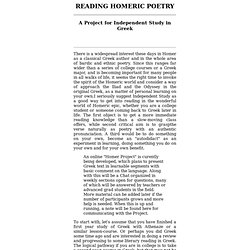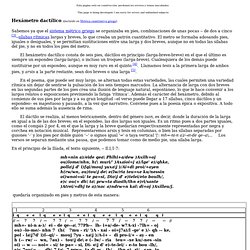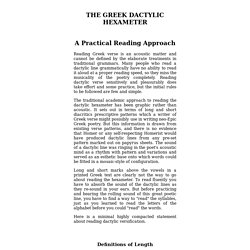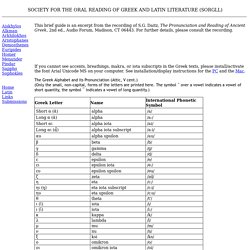

Greek 2 Independent Study in Homer. A Project for Independent Study in Greek There is a widespread interest these days in Homer as a classical Greek author and in the whole area of bardic and ethnic poetry.

Since this ranges far wider than a series of college courses or a Greek major, and is becoming important for many people in all walks of life, it seems the right time to invoke the spirit of the Homeric world and consider a way of approach the Iliad and the Odyssey in the original Greek, as a matter of personal learning on your own.I seriously suggest Independent Study as a good way to get into reading in the wonderful world of Homeric epic, whether you are a college student or someone coming back to Greek later in life. The first object is to get a more immediate reading knowledge than a slow-moving class offers, while second critical aim is to graspthe verse naturally as poetry with an authentic pronunciation. If any of the above are factors in your situation, consider doing a Homer course on your own.
Www.aoidoi.org/articles/meter/intro.pdf. Interclassica.um.es/var/plain/storage/original/application/024cc0cbc23a77581a0b0300f9889b54.pdf. Greek Metrics - Classics. Introduction Greek metrics is the discipline that studies the patterns and arrangements of syllables and words that characterize Greek poetry.

Its domain extends from the study of the properties of syllables (that is, prosody) to the analysis of the structure of the largest poetic components: stanza, strophe, and triad. It overlaps with a number of other disciplines, and there is no agreement on what constitutes the boundaries of metrics proper. Since the patterning is associated with the effect of rhythm, and because most early poetry was sung, metrics is especially allied to the study of the other performed rhythmical arts, namely music and dance.
Meter. In poetry, metre (meter in American English) is the basic rhythmic structure of a verse or lines in verse.

Many traditional verse forms prescribe a specific verse metre, or a certain set of metres alternating in a particular order. The study of metres and forms of versification is known as prosody. (Within linguistics, "prosody" is used in a more general sense that includes not only poetical metre but also the rhythmic aspects of prose, whether formal or informal, which vary from language to language, and sometimes between poetic traditions.) Qualitative vs. quantitative metre. Www.iesfelixburgos.es/articulos/metrica griega.pdf. Www.thesaurus.flf.vu.lt/eiledara/index.php. Welcome to the Chicago Homer. Hexámetro dactílico. Esta página está en construcción: perdonen los errores y temas inacabados.This page is being developed: I am sorry for errors and unfinished subjects Hexámetro dactílico (incluido en Métrica cuantitativa griega) Sabemos ya que el sistema métrico griego se organizaba en pies, combinaciones de unas pocas -- de dos a cinco [3]--sílabas rítmicas largas y breves, lo que creaba un patrón cuantitativo.

El metro se formaba adosando pies, iguales o desiguales, y se permitían sustituciones entre una larga y dos breves, aunque no en todas las sílabas del pie, y no en todos los pies del metro. El hexámetro dactílico consta de seis pies, dáctilos en principio (larga-breve-breve) en el que el último es siempre un espondeo (larga-larga), o incluso un troqueo (larga-breve).
Cualesquiera de los demás puede sustituirse por un espondeo, aunque es muy raro en el quinto [4]. Llamamos tesis a la primera larga de ambos pies, y arsis a la parte restante, sean dos breves o una larga [5]. Reading the Homeric Dactylic Line. A Practical Reading Approach Reading Greek verse is an acoustic matter and cannot be defined by the elaborate treatments in traditional grammars.

Many people who read a dactylic line grammatically have no ability to read it aloud at a proper reading speed, so they miss the musicality of the poetry completely. Reading dactylic verse sensitively and pleasurably does take effort and some practice, but the initial rules to be followed are few and simple. The traditional academic approach to reading the dactylic hexameter has been graphic rather than acoustic.
It sets out in terms of long and short diacritics prescriptive patterns which a writer of Greek verse might posisibly use in writing neo-Epic Greek poetry. Long and short marks above the vowels in a printed Greek text are clearly not the way to go about reading the hexameter. Here is a minimal highly compacted statement about reading dactylic versification. Definitions of Length Determining "Length" Logical Patterning. Interclassica.um.es/var/plain/storage/original/application/f06efcedad30056ccd0f77ca79898103.pdf. Listen to: Greek.
This brief guide is an excerpt from the recording of S.G.

Daitz, The Pronunciation and Reading of Ancient Greek, 2nd ed., Audio Forum, Madison, CT 06443. For further details, please consult the recording. If you cannot see accents, breathings, makra, or iota subscripts in the Greek texts, please install/activate the font Arial Unicode MS on your computer. Classical Language Instruction Project. Greek Life As Depicted in Homer's Epic: The Odyssey. In Homer’s epic, The Odyssey, various aspects of the ancient Greeks are revealed through the actions, characters, plot, and wording.
